By Michele Leggott
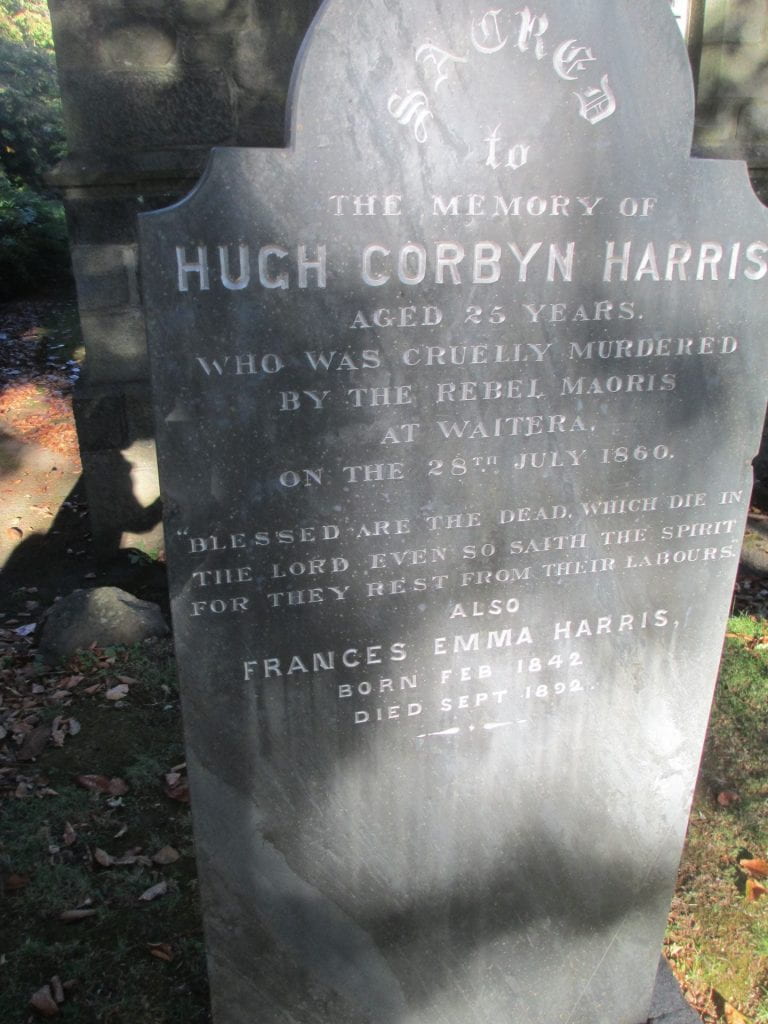
There is only one other headstone like it in the whole of St Mary’s Churchyard. Genealogist John Pickering confirms for us that the stone marking the burials of Hugh Corbyn Harris and his sister Frances Emma Harris is unusual in being slate. The other slate marker belongs to the grave of John Weston, who died in 1857 and was from a prominent New Plymouth family. Slate is not common in New Zealand cemeteries, explains John, as there are so many good sandstones, marble and beach stone, all much cheaper than slate. John, who is responsible for the clean-up in recent years of the 89 markers at St Mary’s, took his morning walk up Marsland Hill by way of the churchyard in order to see if the Harris stone carries a mason’s mark. It doesn’t. And so the field is open for considering a family story that the stone was sent from England. Here is Mary Mountjoy Paddon, cousin of Corbyn and Frances, writing from England in 1922:
I must add that when or after Corbyn Harris was killed a very special sermon was preached, about him, printed & copies sent to England & I think I recollect that a tombstone was erected, whether in New Plymouth or Nelson I do not remember, but I think the stone was sent from England. (The Family Songbook Coda)
Mary Paddon’s memory is hazy but perhaps worth following up. A slate grave marker could have come from Wales. But Devon, where Corbyn Harris and his sisters Emily and Catherine were born, is also noted for its slate quarries. Is it possible that a relative among the English Harrises funded a memorial for Corbyn that referenced his English birthplace?
Time to call in our Plymouth local historians Nigel Overton, Graham Naylor and Clive Charlton. Could they, we asked, hazard a guess as to the origin and date of Corbyn’s marker, based on the evidence of John’s photo?
Nigel:
Interesting that the headstone may have been shipped from England. I am certainly no authority on headstones or local geology, but there are slates in the Southwest which should be distinguishable. The darker colouration and smooth surface quality of most Welsh slate headstones is quite distinctive.
My mother’s family are from North Wales and my great grandfather was a slate miner – and lost his leg in an accident. Like Graham and Clive I can offer some comparison example headstone photos from that perspective. I attach two – one showing the wonderful but long out of use family church at Llanfihangel y Pennant (St Michael’s) – with North Welsh slate markers in the grave yard. I note that two, far right, look of similar period and form to yours.
The second photo is of a restored family headstone of the Edwardian period at St Mary’s Church, Dolbenmaen. I enclose this to highlight the distinctive colour and finish of North Welsh slate.
The valley of Cwm Pennant, originally in Merionethshire, is near Snowdon and the large slate mines at Blaenau Ffestiniog. There is also an old slate works near the valley itself. Dolbenmaen is nearby – but was over the border in Caernarfonshire. Both are now in Gwynedd. Cwm Pennant simply means ‘valley at the head of the stream’. The Welsh poet (Bard) Eifion Wyn wrote the verse: ‘Pam, Arglwydd, y gwnaethost Gwm Pennant mor dlws / A bywyd hen fugail mor fyr?’ – ‘Why, Lord, did you make Cwm Pennant so beautiful / And the life of the old shepherd so short?’ Coincidentally, this was a much loved piece that, as a child, my late mother once read at a local eisteddfod. (1 Apr 2020)
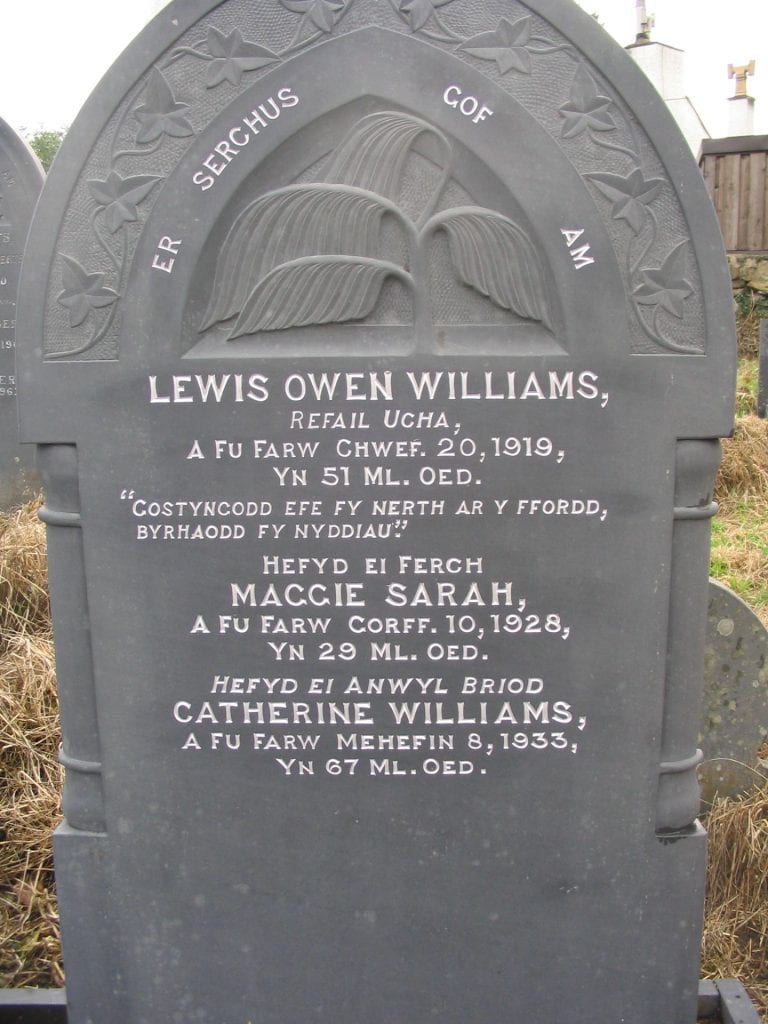
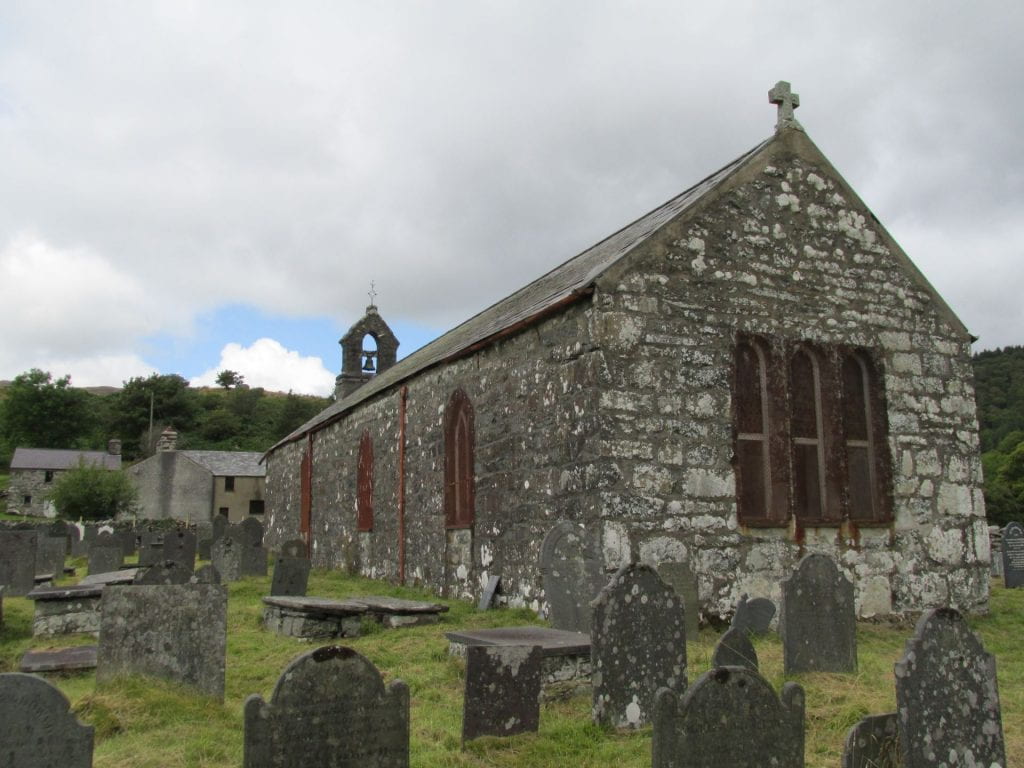
Graham:
I am not a slate aficionado but I can say it is very much in the style of Devon headstones from that era. If slate headstones are a rarity in New Plymouth I highly suspect, like you, that the headstone was made in Devon and shipped to New Zealand. Generally, I’d expect to see the stonemasons name and locality carved into the curved edges at the top of the headstone – this one is blank – but again that’s not wholly unusual as many local examples do not carry this.
I’ve been trawling through my photos on my home PC as I have countless photos of headstones taken from parish churchyards across Devon – all for family history research. There are many similar shaped headstones to that for Hugh Harris – perhaps the largest cluster of similar stones I can readily find are on the attached which show headstones at Plympton St Mary which sits within the modern day Plymouth City boundary. Although this doesn’t in itself prove the headstone in NZ is from Devon, you’ll see the style and shape of the headstone is the same.
You can see a variety of slate headstones all with similar shaped ‘heads’. Plympton St Mary had an active stone mason by the name of Gullett who (I think) produced headstones over a good 50-60 year period – probably a Father and Son business. (1 Apr 2020)
Clive:
On seeing the photographs taken by John in New Plymouth, I suddenly realised I have seen that headstone – and indeed took the attached photograph. We visited St. Mary’s during our all-too-brief but deeply memorable visit to New Plymouth in 2016. I feel a bit sheepish in not having made the connection with the Harris family before now, or noting that slate was unusual in the churchyard. I am also attaching a photo of one of the headstones in the graveyard at Holy Trinity church in Bere Alston. Made of slate, it appears to be exactly the same pattern as the Harris headstone in New Plymouth. Given the restrictions we are currently under, I can’t go straight up to Bere Alston to take a closer look, but will do so ASAP. Also attached, a slate headstone from Bere Ferrers St.Andrews churchyard.
Of course, an expert on gravestones (Graham!?) would surely confirm that the basic outline of the headstones was very widespread (I see he has already!). Others may be able to confirm where the slate was produced. Although North Wales became nationally dominant by the later 19th-century, Delabole in North Cornwall was (and still is to an extent www.delaboleslate.co.uk) a major producer of slate. (2 Apr 2020)
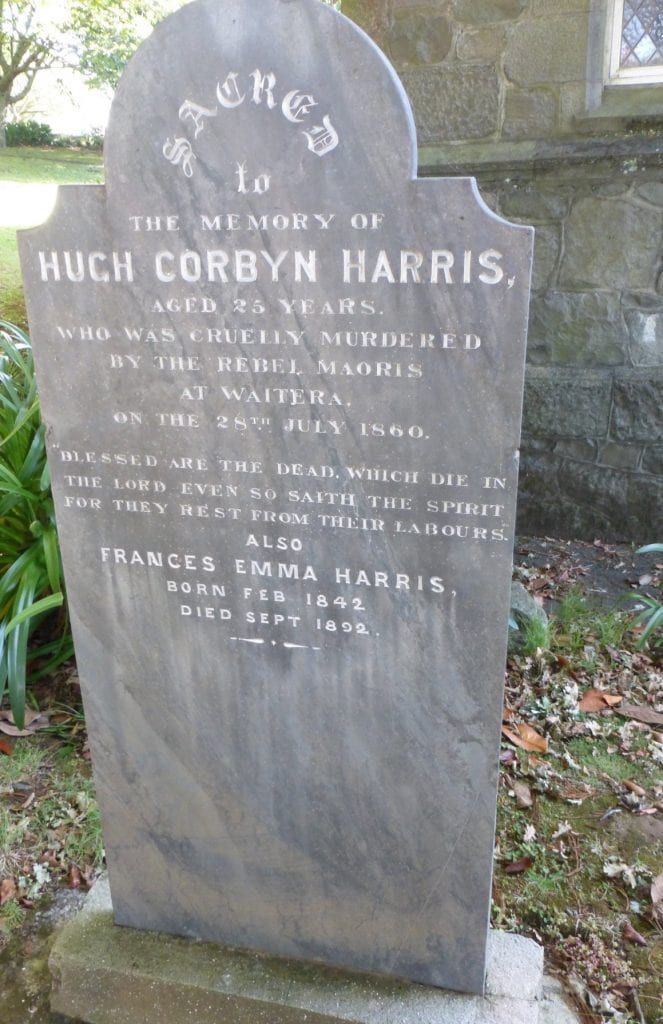
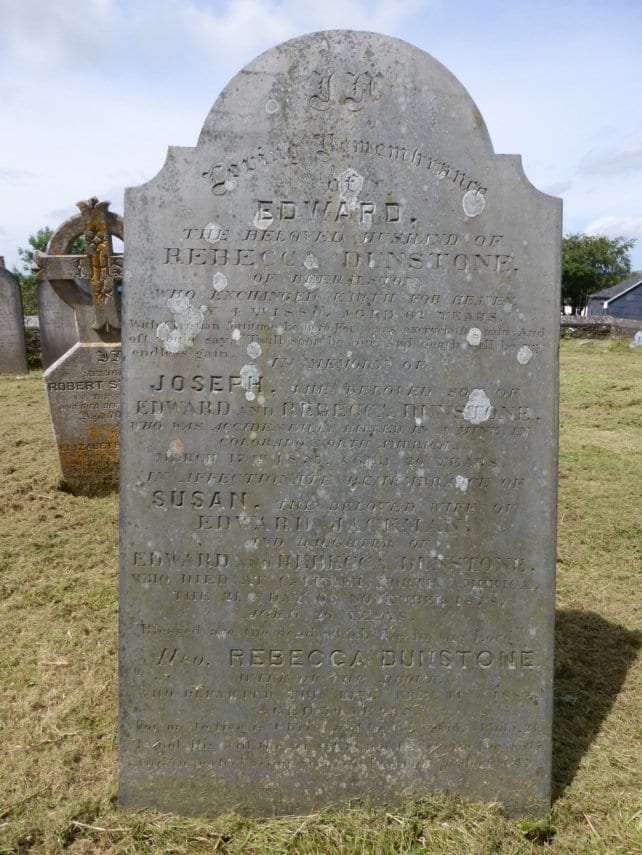

It will take some time to investigate these threads that might link the stone in New Plymouth to a source in Devon or Wales. Meanwhile we can focus on narrowing the date range of Corbyn’s marker in order to help refine the search.
Hugh Corbyn Harris was killed on the beach at Waitara while collecting firewood for the army kitchens 28 July 1860 during the first Taranaki War. He was buried three days later at St Mary’s. The burial is designated as a war grave and the Ministry of Culture & Heritage inspects and cares for it regularly. But the stone John Pickering photographed a few days ago is not the marker of 1860, which is likely to have been a simple wooden cross. The slate marker, expensive and possibly from England, belongs more plausibly to later decades. Corbyn’s New Zealand War Medal was not sent to his father until 1874, and the slate marker could have been erected even later. What we can say is that the inscription for Frances Emma Harris, who died in New Plymouth while staying with her married sister Mary Weyergang, has been added to the marker subsequent to its erection in the churchyard. The point size of the engraving is smaller and the font is different. The marker was in place in 1892 when the family buried Frances with her brother.
Corbyn’s inscription may have been transferred from an earlier marker. The spelling ‘Waitera’ for ‘Waitara’ was uncommon by the 1890s and the phrase ‘cruelly murdered by the rebel Maoris’ uses the language of the war in a way that the immediate family themselves appear not to have indulged in. The loss of their only son had long-lasting consequences for the already financially-strapped Harrises but unlike many of the New Plymouth townsfolk they did not call for retribution for Corbyn’s death, and the blunt words of the engraving on the marker seem out of character. Here is the notice Edwin and Sarah Harris published the day their son was buried:
The afflicted Parents of the late Hugh Corbyn Harris desire to offer their warmest thanks to the Volunteer Rifles, Militia, and other numerous friends, who manifested their respect and esteem for their departed Son, by following his remains to their last resting place. As they are not able to make their acknowledgments in person, they take this opportunity of gratefully assuring them that their voluntary demonstration of kindness and sympathy has afforded much comfort and consolation to his surviving relatives, who mourn the loss of an only and affectionate Son and Brother, but who do NOT “Sorrow as those who have no hope.” New Plymouth, 31st July, 1860. (Taranaki Herald 4 Aug 1860: 2)
Perhaps Christian forbearance faltered when it came to the wording of Corbyn’s epitaph, or perhaps the lost funeral sermon preached by the Reverend Henry Wollaston and sent to England supplied English relatives with harsher words than those used by Edwin and Sarah in their first grief. We simply don’t know.
When the libraries in New Plymouth and Auckland re-open, it will be time to track down if we can a precise date for Corbyn Harris’s slate marker. Meanwhile, looking again at the Harris collection at Puke Ariki, we recalled an early photograph of St Mary’s, taken from the Brougham St end of the churchyard and showing several of the white cross markers at the eastern end of the church. Perhaps one of them belongs to Corbyn Harris.
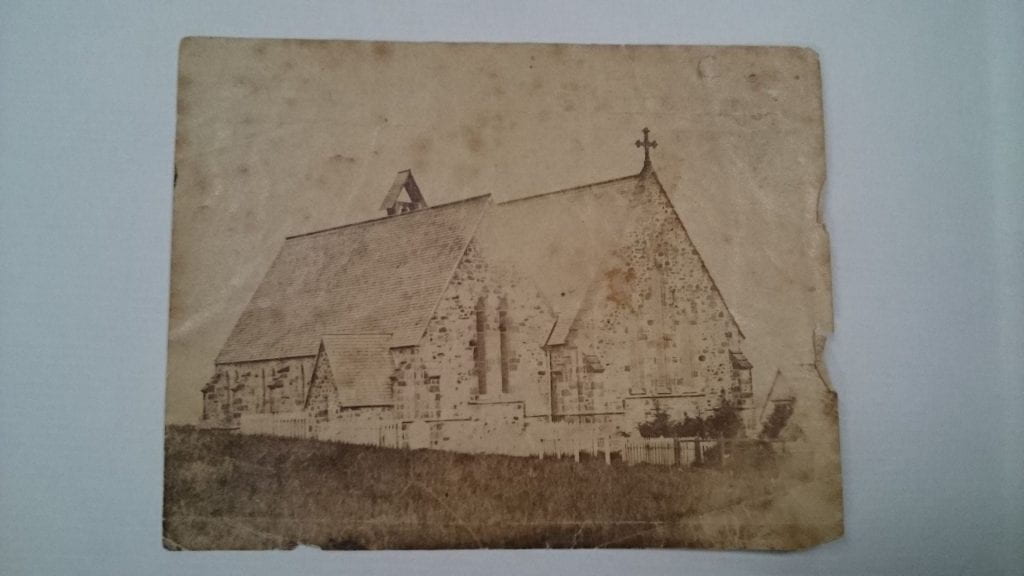
Lead writer: Michele Leggott
Research support: Brianna Vincent, Dasha Zapisetskaya
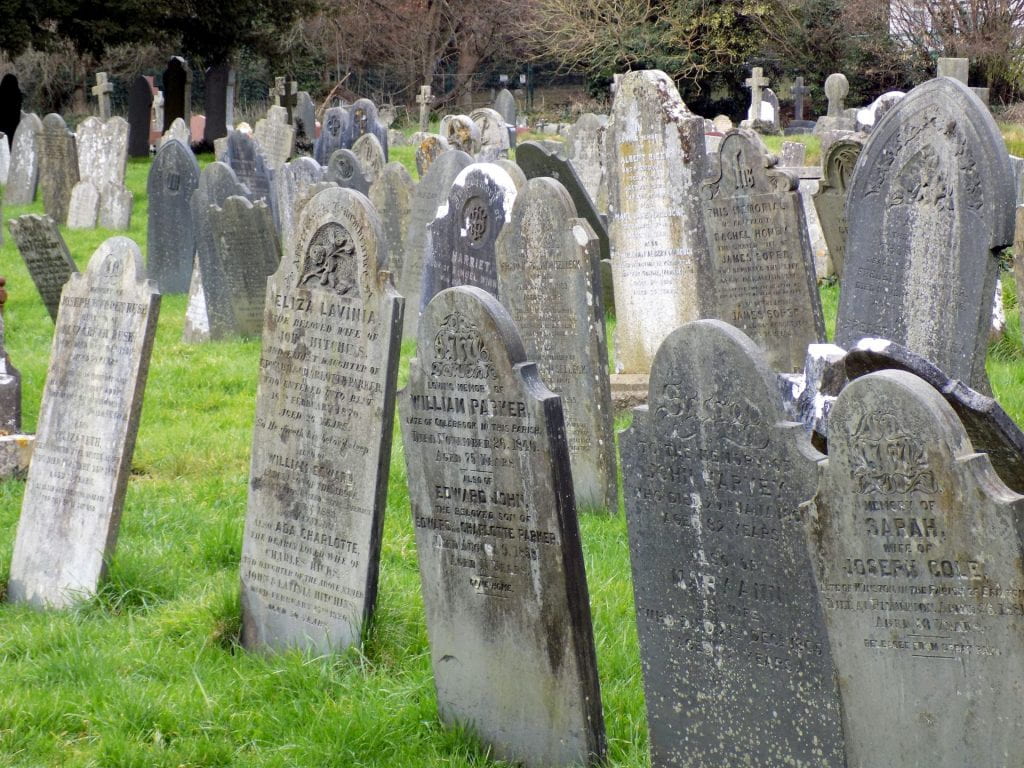
The parish of Plympton St Mary crops up in the BDM records for the Harris family. Worth a look?